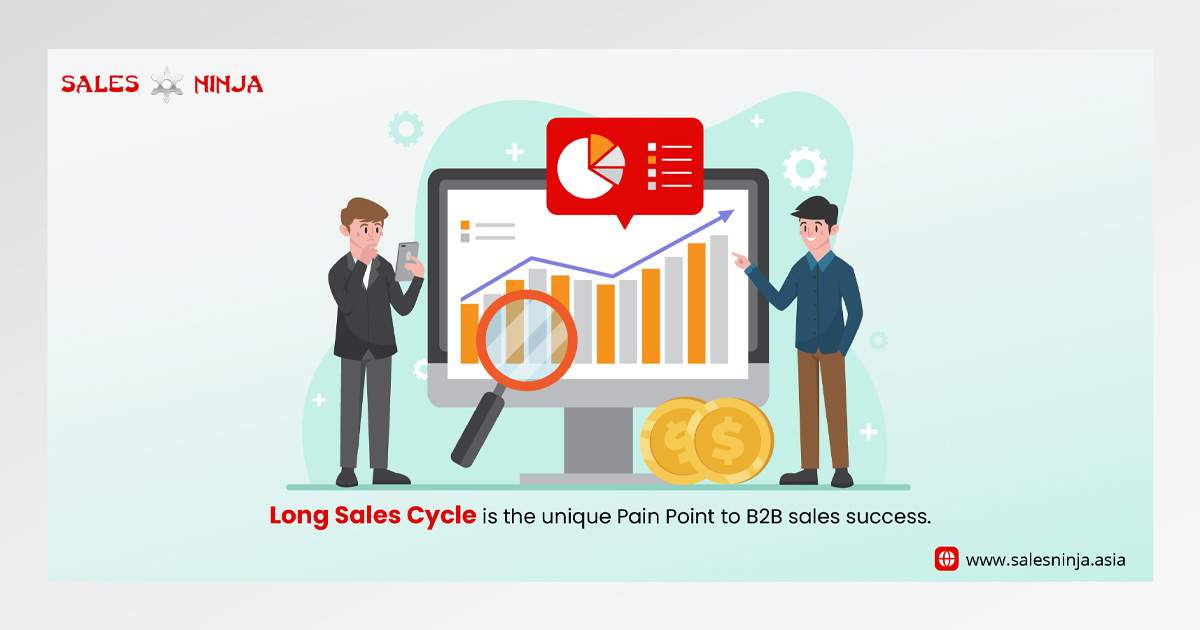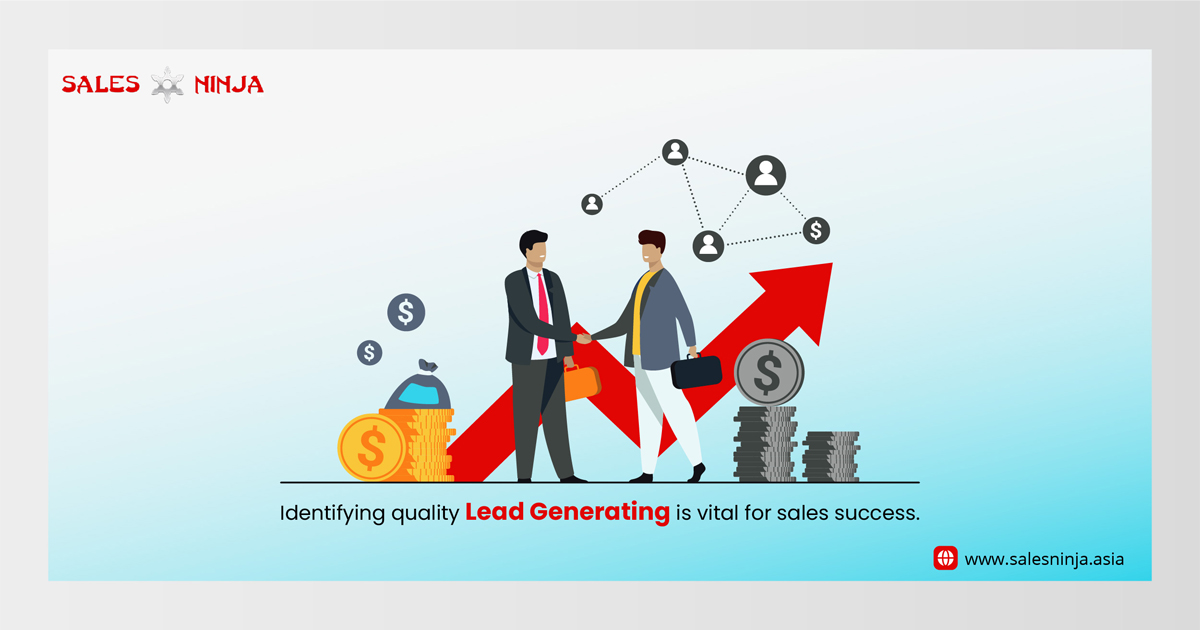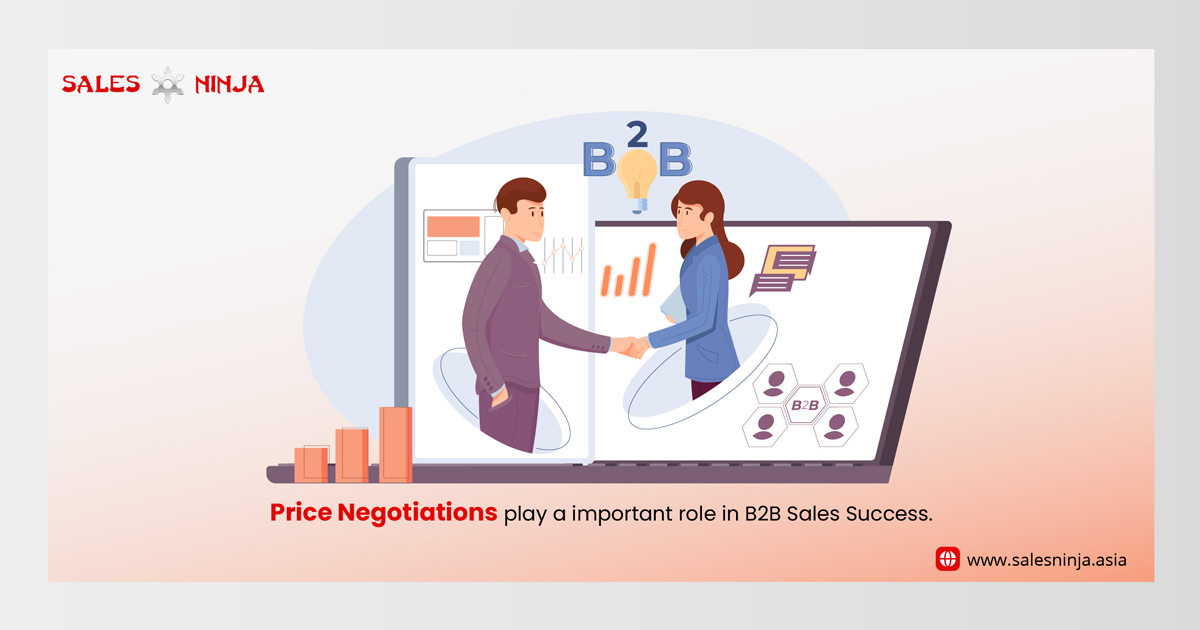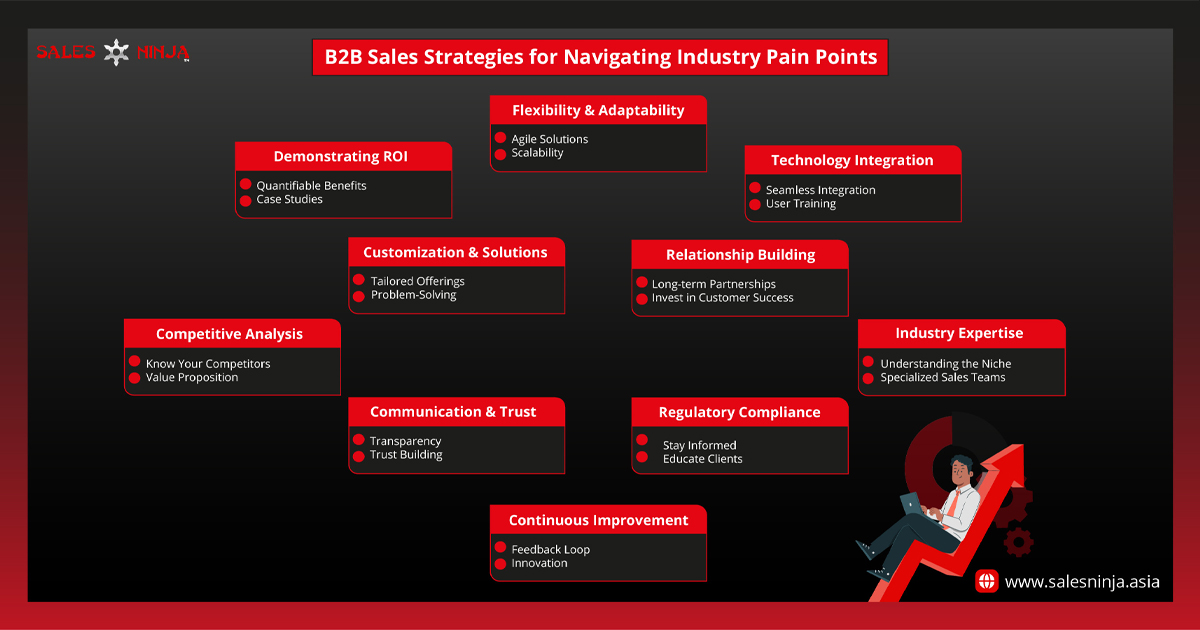Much like unexpected engine trouble on a cross-country road trip, businesses often face roadblocks on their path to success. These roadblocks are known as “pain points,” and they can disrupt the smoothest of operations. Today, we’re going to delve into the heart of these challenges. We’ll explore what they are, how they manifest in the realm of B2B sales, and most importantly, how adeptly navigating these pain points can be the key to unlocking unparalleled success in your B2B sales journey.
Understanding Industry Pain Points
So, what exactly are these “pain points” we speak of?
This means figuring out the problems or challenges that businesses in your industry often face. For instance, imagine you run a company that sells computer software to schools. A common issue in the education industry might be that schools struggle to keep their computer systems updated and secure from viruses. So, understanding this pain point helps you create software that solves this problem for schools, making your product more appealing.
In simpler terms, it’s like knowing what bothers people in your industry so you can offer a solution that makes their lives easier.
Pain Points in B2B Sales
Now that we’ve established what pain points are, let’s shift our focus to the domain of B2B sales. Here, the terrain is dynamic, with its unique set of challenges and obstacles. Understanding these pain points is crucial for anyone navigating this landscape.
Long Sales Cycles
B2B sales often involve extended sales cycles, making it a significant pain point for sales professionals. Unlike B2C (business-to-consumer) sales, where decisions can be made relatively quickly, B2B transactions frequently require a more protracted process. This is because multiple stakeholders, each with their own set of priorities, need to reach a consensus.

Imagine a software company selling a comprehensive enterprise solution to a large corporation. The decision to purchase such a system may involve the IT department, finance, procurement, and various business units. Each department has its criteria, and aligning them can take months, if not years.
Complex Sales Environments
B2B sales often take place in complex environments with numerous variables at play. Understanding and navigating these complexities can be a significant pain point. Sales professionals must have a deep understanding of the industry, market trends, and the specific challenges their clients face.
In the healthcare industry, a medical equipment manufacturer may need to sell its products to hospitals, clinics, and government agencies. Each of these entities operates in a distinct regulatory framework with unique budgetary constraints and patient care priorities. Successfully selling in such an environment requires a nuanced approach.
Lead Generation Challenges
Generating high-quality leads is a critical aspect of B2B sales, but it’s often easier said than done. Identifying potential clients who are genuinely interested and qualified can be a time-consuming and frustrating process.

Intense Competition
Competition in the B2B arena is fierce. Multiple businesses may offer similar products or services, making it challenging to stand out. Price wars can erode profit margins, and the pressure to differentiate is constant.
For example, in the telecommunications industry, numerous companies provide similar services such as internet connectivity and phone systems. To secure contracts, businesses must constantly innovate and demonstrate their unique value proposition.
Customization Demands
B2B clients often expect customized solutions tailored to their specific needs. Meeting these demands can be a pain point, particularly when businesses lack the flexibility to accommodate unique requests. Because adapting existing products or creating entirely new ones can be resource-intensive.
Price Negotiations

Price negotiations are a common pain point in B2B sales, involving intricate discussions between buyers and sellers to determine product or service pricing and terms. This challenge arises due to differing perceptions of value, profit margin concerns, market competition, budget constraints, and the inclusion of value-added services. For instance, a software vendor negotiating with a budget-conscious manufacturing company must strike a balance between accommodating the client’s budget and preserving profitability.
Data Overload
In B2B sales, data overload can overwhelm sales professionals with extensive customer data, market insights, and metrics. Managing and interpreting this data becomes challenging, leading to analysis paralysis, missed opportunities, and reduced efficiency. It’s crucial to find ways to streamline data management and analysis to avoid these pitfalls and harness data’s potential effectively.
Managing Remote Sales Teams
Coordinating and supervising sales teams operating remotely poses logistical and communication challenges, requiring businesses to implement effective strategies for remote team management.
Impact of Pain Points on B2B Sales
So, how do these industry pain points affect B2B sales? Imagine you’re the captain of a ship trying to navigate through rough waters. If you don’t address the challenges posed by the sea, you risk capsizing or getting stuck. Similarly, B2B sales professionals must tackle industry pain points head-on, or they risk losing deals, missing revenue targets, or even damaging their reputation.
Let’s go to a manufacturing equipment example. If you’re selling cutting-edge machinery that can significantly reduce downtime and boost production efficiency, you’re directly addressing the operational inefficiency pain point of your potential clients. Your solution becomes the beacon of hope in their rough sea of challenges. But if you fail to understand their pain points or communicate how your product can alleviate them, your sales efforts might falter.
Navigating Pain Points for B2B Sales Success
Pain points can vary widely and are influenced by factors such as industry trends, market conditions, customer expectations, and internal processes. Recognizing and effectively navigating these pain points is essential for achieving success in B2B sales.

-
The Significance of Identifying Pain Points
Identifying and addressing pain points is crucial for several reasons:
Improved Sales Performance: By understanding and mitigating pain points, sales professionals can enhance their performance, close more deals, and exceed targets.
Enhanced Customer Relationships: Resolving pain points leads to better customer experiences, fostering trust, loyalty, and long-term relationships
Competitive Advantage: Effectively addressing pain points can set a business apart from competitors, making it the preferred choice for customers.
Innovation: Pain points often reveal opportunities for innovation and improvement, driving business growth.
-
Strategies for Navigating Industry Pain Points
Effectively addressing industry pain points involves strategic planning, innovation, and adaptability. Here are some strategies for navigating these challenges:
- Industry Expertise:
- Understanding the Niche: Gain in-depth knowledge of the specific industrial niche you’re targeting. This includes understanding industry trends, regulations, and challenges.
- Specialized Sales Teams: Employ sales teams with expertise in the industrial sector. These teams should be well-versed in industry-specific terminology and challenges.
- Relationship Building:
- Long-term Partnerships: Focus on building long-term relationships with industrial clients. Industrial buyers often seek trusted partners rather than one-time vendors.
- Invest in Customer Success: Offer exceptional post-sale support and service to ensure client satisfaction and loyalty.
- Customization and Solutions:
- Tailored Offerings: Customize your products or services to meet the specific needs and pain points of industrial clients.
- Problem-Solving: Position your offerings as solutions to industrial challenges, addressing pain points directly.
- Demonstrating ROI:
- Quantifiable Benefits: Clearly articulate how your products or services deliver quantifiable benefits, such as cost savings, increased efficiency, or reduced downtime.
- Case Studies: Provide real-world examples and case studies showcasing successful outcomes achieved by industrial clients using your offerings.
- Regulatory Compliance:
- Stay Informed: Keep abreast of evolving industry regulations and ensure that your offerings comply with relevant standards.
- Educate Clients: Help industrial clients understand how your offerings align with and simplify compliance efforts.
- Technology Integration:
- Seamless Integration: If your products involve technology, ensure they integrate seamlessly with existing industrial systems and processes.
- User Training: Offer training and resources to help industrial clients effectively implement and utilize your technology-driven solutions.
- Communication and Trust:
- Transparency: Maintain transparent communication with industrial clients regarding product/service features, pricing, and timelines.
- Trust Building: Prioritize building trust through consistent reliability, on-time delivery, and honest dealings.
- Flexibility and Adaptability:
- Agile Solutions: Be prepared to adapt your offerings based on the changing needs and challenges of industrial clients.
- Scalability: Offer scalable solutions that can grow with your client’s business.
- Continuous Improvement:
- Feedback Loop: Establish a feedback loop with industrial clients to gather insights for product/service enhancements.
- Innovation: Invest in R&D to continuously improve your offerings and stay ahead of competitors.
- Competitive Analysis:
- Know Your Competitors: Conduct through competitive analysis to understand how your offerings compare and identify areas for differentiation.
- Value Proposition: Emphasize what sets your products or services apart from competitors in terms of solving industrial pain points.
Navigate the Pain Points with ‘B2B Sales Ninja’
In the journey of navigating industry pain points for B2B sales success, having the right tools and training can make all the difference. That’s where ‘B2B Sales Ninja‘ steps in. This comprehensive training program is designed to equip sales professionals with the skills, knowledge, and strategies needed to excel in the challenging landscape of B2B sales. With a focus on understanding industry-specific pain points and addressing them effectively, ‘B2B Sales Ninja‘ empowers individuals and organizations to stand out in their sectors. By enrolling in this program, you gain access to proven methodologies and cutting-edge techniques that enable you to tackle pain points head-on.
Event Brochure: https://drive.google.com/file/d/1U235e5gGyyOy35wFWXiUnfElbnhOP6ze/view
Event Registration Link: https://salesninja.asia/b2b_sales_ninja/

Successfully navigating industry pain points is akin to steering a ship through turbulent waters. By understanding these challenges, customizing solutions, and prioritizing customer needs, sales professionals can emerge victorious, securing deals and fostering long-lasting client relationships. Much like a skilled captain who can brave any storm, B2B sales experts who master the art of addressing industry pain points become invaluable assets to their organizations.
However, mastering this skill is an ongoing journey, one that requires dedication, adaptability, and a commitment to continuous improvement. Join us in our ‘B2B Sales Ninja: Target any customer you want – AI powered‘ training program. Equip yourself with the knowledge and tools needed to not only understand industry pain points but also to navigate them with finesse.
Don’t miss this opportunity!




